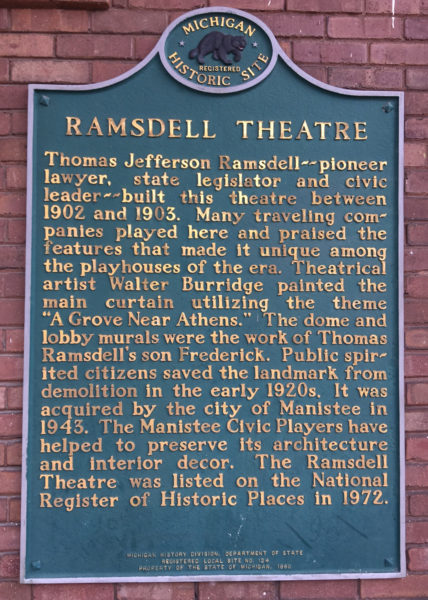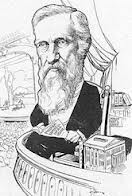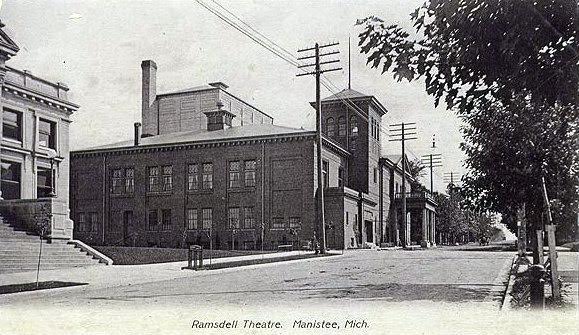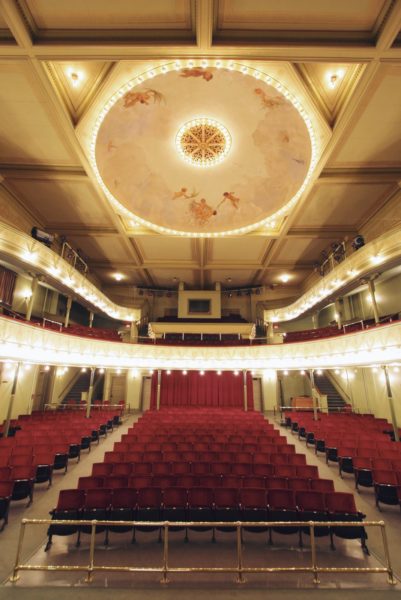Learn about Ramsdell Theatre History
 Listed in the National Register of Historic Places, The Ramsdell has served the Michigan coastal community of Manistee for over a 100 years. Built in 1903 by local lawyer and philanthropist Thomas Jefferson Ramsdell, the Theatre and Grand Ballroom were designed by renown Chicago architect Solon Spencer Beman. The Theatre was comparable to the best opera and vaudeville houses at the time of its construction and though extensively renovated over the years, retains much of its original architecture and charm.
Listed in the National Register of Historic Places, The Ramsdell has served the Michigan coastal community of Manistee for over a 100 years. Built in 1903 by local lawyer and philanthropist Thomas Jefferson Ramsdell, the Theatre and Grand Ballroom were designed by renown Chicago architect Solon Spencer Beman. The Theatre was comparable to the best opera and vaudeville houses at the time of its construction and though extensively renovated over the years, retains much of its original architecture and charm.
The Ramsdell Theatre and Hall
On September 4th, the Ramsdell Theatre opened to a standing-room-only audience to view the acclaimed production of “A Chinese Honeymoon” by the traveling New York Casino Company. It opened to rave reviews and began the 87-year history of community operations and usage that has survived both world wars, the decline and rebirth of a historic downtown, and the advent of home videos. This facility has always been and always will be a community-oriented operation and that perhaps is what keeps the hope, spirit, and vitality on its current path.

Thomas Jefferson Ramsdell
Thomas Jefferson Ramsdell
The public spirit and generosity of its benefactor, Thomas Jefferson Ramsdell, are well outlined in the history of Manistee. This well-to-do lawyer worked for the cultural and economic improvement of this small community in northwest Michigan. He helped build the first bridge across the river, opened the first hardware store in Manistee, was instrumental in establishing the first newspaper, helped to found the First National Bank, and the Manistee Water Works. He invested in real estate and when the Scandinavian Opera House burned, he invested over $100,000 to create an architectural and cultural landmark that is still standing today – The Ramsdell Theatre and Hall.
 Construction
Construction
Almost two years earlier, in 1901, construction had begun on the building at the corner of First and Maple streets. Mr. S. Beman, a prominent Chicago architect, was contracted to design and build this community cultural center which not only included a theatre but also incorporated an assembly hall as well. (The theatre and hall are separated by a solid wall of masonry making the buildings distinct from each other.) The exterior is of red brick with six large columns supporting the portico over the main entrance to the theatre on Maple Street – a very classic Colonial design.
The Hall
The hall portion of the structure was completed first. The first floor was devoted to parlors, a drawing room, a cloakroom and a kitchen. The second floor was entirely dedicated to a dance hall with an orchestra balcony and fireplace. The Manistee Retail Clerk’s Union christened it with a ball on December 12, 1902. The official opening was held six days later with a ball held by the Ramsdell family.
Theatre Stage
As 1902 came to a close, work on the theatre was still progressing. It was to be constructed and equipped so that the best-traveling companies in the country could be obtained. The footage of the stage and backstage areas were comparable to the best opera and vaudeville houses in the country. The Manistee Civic Players were the resident company offering entertainment to the community for over 60 years. In 1939, the Manistee Civic Players were formed and secured permission from the Butterfield Theatre chain for the use of the Ramsdell for rehearsals and performances of two productions each year. Their first production was “The Night of January 16th” on September 14, 1939.
Today, the stage measures 34 feet deep and 60 feet wide. The gilded proscenium arch is 26 feet wide. The gridiron is 70 feet above the stage while the two fly galleries are almost 30 feet above the stage. There is a paint gallery that is 34 feet above the stage floor and enables artists to paint scenery cloths while viewing them vertically. The stage floor is graced with nine trapdoor platforms, six of these can be raised, and the other three can only be lowered into the basement.
Theatre Features
 The most striking feature of the green and gold interior is the horseshoe balcony supported by numerous pillars that extend to the tin-plated ceiling. Some very famous artists completed the interior decoration in their right. Walter Wilcox Burridge, a renowned scenic painter (who did the original “Wizard of Oz” scenery), painted the front drop curtain, entitled “A Grove Near Athens.” Frederic Winthrop Ramsdell, Ramsdell’s son, painted the two lunettes in the lobby and the lavish dome in the house, depicting Venus riding her chariot through the heavens, surrounded by cherubs. The original seating capacity was 1,200, including the gallery seating reserved for Manistee’s lower and laboring classes. (The gallery is no longer in use due to fire safety rules.) Today, the house seats 489, which includes four boxes, two on each side of the stage and two loges in the lower balcony.
The most striking feature of the green and gold interior is the horseshoe balcony supported by numerous pillars that extend to the tin-plated ceiling. Some very famous artists completed the interior decoration in their right. Walter Wilcox Burridge, a renowned scenic painter (who did the original “Wizard of Oz” scenery), painted the front drop curtain, entitled “A Grove Near Athens.” Frederic Winthrop Ramsdell, Ramsdell’s son, painted the two lunettes in the lobby and the lavish dome in the house, depicting Venus riding her chariot through the heavens, surrounded by cherubs. The original seating capacity was 1,200, including the gallery seating reserved for Manistee’s lower and laboring classes. (The gallery is no longer in use due to fire safety rules.) Today, the house seats 489, which includes four boxes, two on each side of the stage and two loges in the lower balcony.
Restoration
After years of use and some benign neglect, the building needed significant attention. In the 1990s, as the city began to emphasize its Victorian heritage, a group was formed to guide a restoration project for the theatre and the ballroom-side of the building. Over the years private donors, the City of Manistee, local businesses, social and service organizations and patrons, including the Manistee Civic Players, have helped match grants to bring this treasure back to its original beauty. Together, they raised close to 4 million dollars. There were also several significant in-kind gifts of repairing and restoring woodwork and lighting fixtures. James Earl Jones, who began his career on our stage, has returned twice to help raise funds.
The preservation architects were Quinn Evans, who designed the master plan, and Conrad Schmidt Studios, who did much of the decorative wall and ceiling work. The 1903 act curtain that was created by Walter Burridge is the only existent theatre drop of his. It was restored by Bradley Vandermoere, as were the dome painting and the lunettes in the lobby. The American Seating Company, who made the original seats, replaced the seats. The unique wooden armrests were restored and reused. 465 seats were donated as memorials or honorariums. An elevator has been added to provide comfortable access to all. The theatre and attached exhibit hall and ballroom have been restored as well and are now used year-round for:
An endowment has been established at the Manistee County Community Foundation to help maintain the restoration and preservation into the future.
